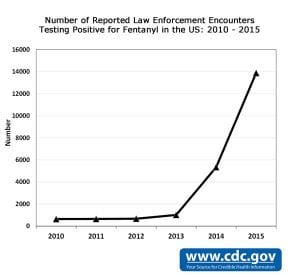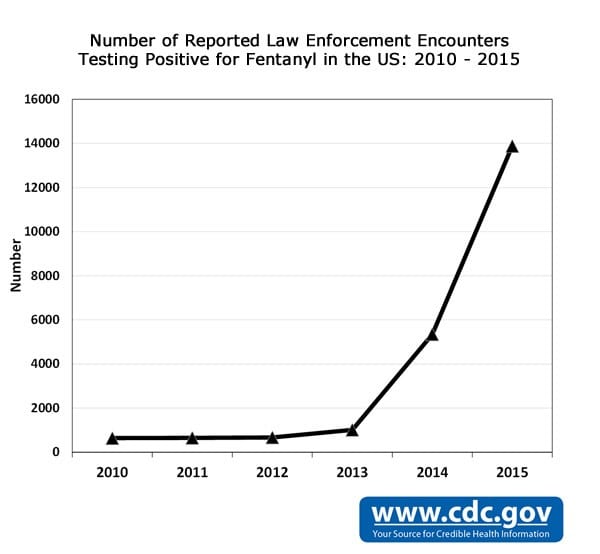Have you ever heard someone say, “It’s almost a relief to find just heroin or just cocaine or just crack.”? Have you ever heard a police officer say how relieved they are they only found any of those three drugs during a drug bust? The above quote comes from East Liverpool, Ohio Police Officer, Chris Grant, who inadvertently overdosed on fentanyl by simply brushing it off the back of his shirt. The report states that within two minutes Green crashed to the floor and woke up in the hospital to learn he had overdosed. No, he didn’t snort or ingest the drug in any way. He touched it with his hand. Some may say that’s impossible and the statistics of fentanyl overdoses don’t lie. Fentanyl acts on the same receptors in the brain as opioids except it can be 50 to 100 times stronger than its predecessors: heroin, methadone, oxycodone and the like. Fentanyl is a synthetic drug that had found its way into the black market over the last four to five years. The drug has become an advantageous pursuit for drug dealers because of the strength of the drug, which mirrors the same pursuit of the user to find the next, more exhilarating high, often ignoring the potential pitfalls such as…death. The number of overdoses has been increasing at an alarming rate over the last four years.
- The death rate of synthetic opioids other than methadone, which includes drugs such as tramadol and fentanyl, increased by 72.2% from 2014 to 2015
- The number of states reporting large numbers of fentanyl encounters substantially increased from 2014 to 2015, with 8 states reporting more than 500 encounters in 2015 compared to 2 states in 2014 and zero states in 2013
- The following states reported over 500 fentanyl encounters in 2015: Kentucky, Virginia, Ohio, Pennsylvania, New Hampshire, Massachusetts New Jersey and Florida

Regional Problem
As indicated in the aforementioned statistics, it appears fentanyl has become a regional problem, mainly concentrated in the Midwestern and Northeastern Regions of the United States, with one outlier being Florida. As we may be learning during our current President’s seemingly fruitless attempt to keep coal as a hot commodity, many of the aforementioned states have a large concentration of physically taxing occupations such as timbering, agriculture and, wait for it, coal mining! The current prescription and illicit opioid epidemic originated from the prescription pain killer epidemic. Heavy prescription of painkillers such as oxycodone and hydrocodone began in the late 1990s and has become a public health epidemic, resulting in a quadrupling of prescription opioid overdoses between 1999 and 2015. Prescribing of opioid pain killers has increased at a similar rate over the same time period. Go figure.
So, how did we get here?
Like any business, a drug company will attempt to market their business in areas that will have the largest prediction for success. For example, if you go to Texas and California, you’re going to find that there are a lot more Hispanic food restaurants and food options per capita as compared to Oregon. The reason for this is the fact that Texas and California border Mexico and have the two highest Hispanic populations in the United States. When prescription opioid pain killer companies were developing their marketing plans in the mid-to-late 1990s they compiled a list of physicians that treated people for chronic pain disorders. The database revealed that states such as Virginia had a higher rate of chronic pain patients and any dunce looking at the map of results would say, ‘why don’t we sell our drugs there’. In addition to identifying where to send the pharmaceutical representatives, the company that sold OxyContin had lucrative sales bonuses for their employees, which only increased their reps’ desire to sell more drugs. It’s possible that liking money is not exclusive to Dax Shepard’s character, Frito, of the movie Idiocracy. All jokes aside, it’s pretty scary that drug companies used such deceptive marketing tactics as they have been will be gummed up in several lawsuits for several years for their marketing of “non-addictive” pain killers. Most recently, the state of Ohio decided to sue 6 pharmaceutical companies, most notably Purdue Pharma. Not so ironically, Purdue Pharma was on the forefront of marketing of OxyContin to vulnerable areas in the mid-1990s. Ohio’s lawsuit alleges that Purdue Pharma:
- Overstated the benefits of chronic opioid pain therapy
- Targeted susceptible prescribers and vulnerable patient populations such as veterans and elderly patients
- Violated state anti-fraud and consumer protection laws
Can Chronic Pain be Managed?
What’s wrong with a physician wanting to assist a patient with managing his or her chronic pain? There is a consensus that using opioids for acute or severe cancer related pain can be useful and improve physical functioning and quality of life for over short periods of time. That’s something that cannot be denied. However, the use of opioid pain killers for non-cancer related pain for long-term relief has not proven to be efficacious in improving the patient’s overall functioning beyond short-term relief. To extend the point, long-term use of opioid pain killers can result in the following:
- Respiratory depression
- Sedation
- Constipation
- Nausea
- Inconsistent improvement in functioning
- Opioid-induced hyperalgesia
- Adverse hormonal and immune effects of long-term opioid treatment
- A high incidence of prescription opioid abuse behaviors
- An ill-defined and unclarified risk of iatrogenic addiction
On May 10, 2007, Purdue Frederick Company Inc., an affiliate of Purdue Pharma, along with 3 company executives, pled guilty to criminal charges of misbranding OxyContin by claiming that it was less addictive and less subject to abuse and diversion than other opioids, and will pay $634 million in fines. It’s interesting to see Purdue Pharma named in the Ohio lawsuit ten years later for similar allegations.
Can Fentanyl Be Useful?
Fentanyl was originally meant for cancer patients that were experiencing significant chronic pain that affected their lives enough to make it seem unlivable. The introduction of the fentanyl patch at least made their days more bearable and they were able to eat more regularly and have a higher quality of life. For cancer patients that are experiencing chronic pain, fentanyl patches have proven to be effective in certain case studies, suggesting controlled administration of the patch could be beneficial to a patient even if it is only for the last few weeks of his or her life. The introduction of the patch has eliminated the need to take several doses of opioids orally on a daily basis, which can have undesirable side effects.
Back to the Bad Side of Fentanyl
On June 1st, 2017 New York City issued an advisory for recreational drug users to be leery of purchasing cocaine. The advisory has been issued for good reason as New York City statistics show that 37% of overdose deaths in 2016 involved cocaine and fentanyl without heroin, which is up from 11% in 2015. That’s a sharp increase and it’s not just the addicts that are at risk anymore due to the strength of fentanyl. Don’t forget a police officer, who’s presumably drug tested on a regular basis, nearly died just from touching fentanyl let alone ingesting the drug. In cases where fentanyl labs have been busted the criminals have warned law enforcement of touching the powder without gloves due to the high potency of fentanyl. The occasional cocaine users, who won’t have a high tolerance for fentanyl, can die from one dose.
Buyer Beware
Fentanyl has become a hot alternative to heroin and other opioids because of the increased restrictions around opioid prescriptions therefore limiting its availability and creating a balloon effect. A balloon effect often happens when enforcement agencies begin cracking down on one drug epidemic only to see a new one rise from the ashes just when they think they’re winning the war on drugs. Just like drug companies saw an opportunity in states with chronic pain patients, drug dealers are constantly looking for new opportunities to market and sell their drugs, especially if they can make more money in the process and even make the drug themselves. The Drug Enforcement Agency reports that one kilogram of fentanyl can be purchased from China for $3,000 to $5,000 and sold on the black market for a profit of approximately $1.5 million dollars. The acting US attorney for the northern district of Ohio Cleveland, Carole Rendon, is quoted saying “we have seen an influx of fentanyl directly from China” and that “it’s being shipped by carrier. It’s hugely concerning because fentanyl is so incredibly deadly”. As most of us know, the famous singer Prince died from a fentanyl overdose which was masked as counterfeit hydrocodone. That’s exactly what the state of Ohio and other states near Ohio are seeing. They are finding fentanyl in counterfeit pain killers and benzodiazepines (i.e. Xanax). There have been strings of reports over the last couple of years across the country that entail busting drug dealers selling counterfeit pain killers and benzodiazepines and home-based labs producing counterfeit drugs that contain fentanyl.
The Newest War on Drugs
Who do we target to stop the newest drug epidemic? China, Mexico, pharmaceutical companies, dealers, labs, users, politicians, employers of physically taxing jobs or physicians? There’s no clear answer of who or what the drug enforcement agencies, local law enforcement agencies, lawyers, substance abuse clinics, centers for disease control and prevention and food and drug administration officials should put in their crosshairs. What’s becoming clearer is that it actually isn’t crazy to say that it’s relieving when a drug bust only involves crack, cocaine or heroin. With fentanyl essentially becoming an invisible killer due to its presence in recreational drugs that formerly didn’t have such a high death rates, the path to extinguishing or at least mitigating the epidemic remains unclear. Sure, some users knowingly purchase fentanyl because it possesses the most bang for the buck, being 50 to 100 times stronger than opioids. The irony of it all is that the chronic fentanyl and opioid users are actually at lower risk of death because of the tolerance they’ve created over time. At the end of the day, we know it’s an addiction problem that afflicts millions of Americans that should be addressed with comprehensive and longer-term treatment programs that involve behavioral and pharmacological interventions. A researcher for Centers for Disease Control and Prevention sums up the current progress in stating, “We’re trying to get a better handle on how widespread it is and where it is”. We clearly have a long way to go and we should not let it overtake this country much like the opioid epidemic has for the last 20 years.

